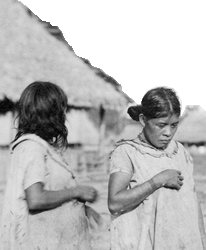°Arcus°
Home » Creation stories » South America
CREATION STORIES FROM SOUTH AMERICA
APAPOCÚVA
In the beginning, all as dark. Amidst the darkness, there were bats without number, who were constantly fighting one another. Eventually, Our Father - the sun - appeared in the midst of the murk and created the earth, which he placed upon the Eternal Cross to support it. Next, he made Our Mother, who gave birth to twins, Our Older Brother and Our Younger Brother. This pair continued the work of creation. Another son of Our Father was Tupa, the lord of thunder.
Thereafter, Our Father has remained aloof from his creation, preferring to leave it in the hands of the demiurgic brothers - so much so, that some believe that Our Elder Brother is to be identified with the sun. According to this account, Our Younger Brother - i.e. the moon - was singularly unsuited to the task of creation: he was constantly making mistakes, which necessitated the attentions of Our Elder Brother, who was always fixing the messes left behind by his twin. Our Elder Brother also gave fire and sacred dances to the people.
The ancient bats, however, remain: their return is much to be feared, as this would herald the end of creation and a return to the chaotic state.
APURINÃ
According to their traditions, the creator was Mayuruberu, the chief of the Storks. Mayuruberu (or Maturuberu) caused a flood by making a pot of boiling water in the sun overflow. This destroyed all plant life. Indeed, the only survivors were the Apurinã, who established the new order. Mayuruberu ordered that anyone who did not work would be devoured by him.
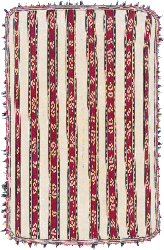
AYMARA
Kun, the god of snow, began the work of creation. Once he had finished, he became annoyed at the early humans, which led him to cover his work with snow and ice. Thereafter, the gods of fertility send the Eagle Men, their sons, to create a new race of men, known as the Paka-Jakes, who dwell near Lake Titicaca.
Another creator, who is closely associated with the enigmatic and advanced builders of the Tiwanaku complex, was Pachacamac. Pachacamac had his origins within Lake Titicaca, from where he emerged to create the universe from nothing. His early creations included rebellious giants, who he destroyed by means of flood, before creating the first humans from clay. These then emerged from a number of openings in the earth, forming the tribes.
GUARANÍ
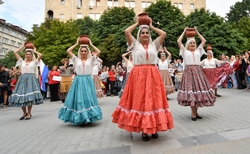
In the beginning, Tupa created the universe from nothing. With the aid of Arasy (the moon), Tupa descended from heaven to earth, landing at Aregua, upon a hill, from where he created the world around it. Tupa was the creator of the first Guaraní, Rupave and Sypave, to whom he bestowed the breath of life. Once Rupave and Sypave were created, Tupa left the earth.
The eldest son of Rupave and Sypave was Tume Arandu, who was soon joined by his brother Marangatu. Both of these men were early leaders of the Guaraní. The third son of the couple was Japensa, a trickster figure.
However, the next generation included Karena, the mother of seven monsters. One of these was killed thanks to the sacrifice of Karena's aunt Porasy.
GUARAYO
In the beginning, the earth was a watery place. The first place to exist within this primordial cosmos was a patch of bullrushes, among which slithered the worm-like Mbir. Some time later, Mbir - also known as Miracucha - took on the form of a man, and proceeded to form the ordered cosmos from this primeval chaos.
Other entities around by this stage were Zaguagua, the sun, and Abaangui. The latter wished to become human too, and, after some failures, he finally succeeded. Unfortunately, Abaangui's human form possessed a nose of vast proportions. This led to him cutting it off: Abaangui's nose eventually became the moon.
The earliest ancestor of the Guarayú was Tamoi ("grandfather"), who taught the people the arts of hunting, fishing and agriculture, as well as mastery of fire. Eventually, having given his people their mode of life, Tamoi departed for the west. His wife and child remained behind in the form of rocks held to be sacred by the Guarayú.
Tamoi's westward journey laid the foundations for the fate of the people after death. They too would undertake that journey, with their souls heading towards the setting sun. On the way, they would meet a figure known as the Grandfather of Worms who only allows the souls of the righteous to pass by. If an unrighteous soul encounters him, he grows so vast that he prevents ingress to the blessed realm.
INCA (TAWANTINSUYU)
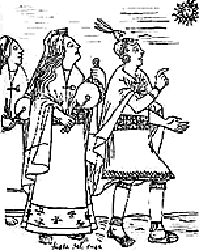
At the beginning of time, Viracocha awoke in Paqariq Tampu, or else rose from the great Lake Titicaca, during a time when all was dark. His first action was to illuminate the cosmos, fashioning sun, moon and stars. He made the earliest "humans" by breathing into stones, but these were a race of giants with limited intelligence. This first creation displeased Viracocha, who destroyed the giants in a deluge, before proceeding upon a second attempt, this time making use of smaller stones. The flood itself was known as Unu Pachakuti, and it resulted in the deaths of the people living around Lake Titicaca. It lasted for sixty days.
In some accounts, two people were spared, in order to continue the planned development of human civilisation. Some legends name the pair as Manco Cápac, the son of Inti, and Mama Uqllu. Finding this race more to his liking, Viracocha took himself off into the west, walking over the waters of the Pacific Ocean, with the promise that he would return when his people found themselves in distress. The Spanish, who recorded these native legends, were told that Viracocha was "of medium height, white, and dressed in a white robe [carrying] a staff and a book."
Viracocha was the father by Mama Qucha of Inti, god of the sun, as well as Mama Killa and Pachamama, and the sons Imahmana Viracocha and Tocapo Viracocha. This latter pair were dispatched to the other tribes to the north to see if they still adhered to Viracocha's plans.
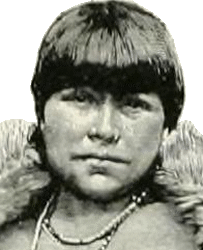
KAWÉSQAR
In Kawésqar tradition, creation was the work of the supreme being, Xolas. Their mythology otherwise resembles that of the Selk'nam.
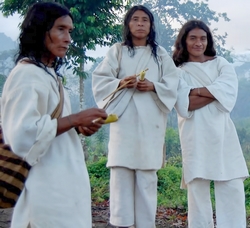
KOGI (KÁGABA)
The Great Mother created the universe from nothing. She created songs, seeds, nations and thunder, trees and all that grows and lives.
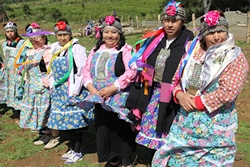
MAPUCHE
There are two worlds, the Wenu Mapu and Minche Mapu, the heavens and the underworld, in the middle of which is the inhabited world, Nag Mapu or Naq Mapu. Wenu Mapu is the home of the four-part Ngenechen: -
- Fuchá, the older male;
- Kufé, the older female;
- Weche Wentru, the younger male; and
- Ulcha Domo, the younger female.
Between Wenu Mapu and Nag Mapu lies Anka Mapu, the domain of the spirits of the ancestors. Humans dwell on Nag Mapu, while demonic entities known as the Wekufu live in Minche Mapu. Other spirits include the pillanes - a group of revered male spirits (including ancestors) - and Wangulen - their female counterparts - as well as the Ngen, spirits of nature produced by the Pu-am, the universal soul.
The Antü was the most powerful pillán, representing the sun. Another powerful member of this group was Peripillán. These two became the fathers of Ten Ten-Vilu (or Trentren-Vilu) and Coi Coi-Vilu (or Caicai-Vilu), two huge serpents representing land and water respectively. This pair fought a great battle for control, before coming to terms, which resulted in the Chilean landscape of today.
MOSETÉN
The creator of the cosmos as we know it was Dobitt, who lived in heaven, which took the form of a raft floating through space. Dobitt fashioned the first humans from clay and placed them on earth, sending his son Keri, in the form of a white condor, to check on the planet. Sadly, the rope by which Keri was descending broke, resulting in his falling to his death. From Keri's head, Dobitt made a fish, before going to the earth to complete his work of creation, forming all the animals and plants, and teaching humans the necessary skills to survive. The sky was raised from the earth by means of a gigantic serpent.
MUNDURUC
In the beginning, there was Karusakaibo, the creator, and his assistant, the armadillo Daiiru.
One day, having somehow invoked Karusakaibo's wrath, Daiiru hid within the ground. Karusakaibo blew into the hole and stamped down with such force that Daiiru was blown out. He informed Karusakaibo of what he had found there, namely humans, and the pair reconciled. They decided to bring these first people to the earth's surface, and attempted to do so by means of a rope of fine cotton, to the end of which Daiiru was tied. He showed the people how to climb out, but the weight of so many of them caused the rope to break, leaving half of the people in the underworld, where they remain.
As for the underworld, it is said that this is a realm opposite to our own: the sun rises there in the west and moves eastward, while the moon is there when it is daytime here. Meanwhile, those who made it to the surface emerged at Necodemos. The people who bear the most striking resemblance to Karusakaibo are the Mundurucs.
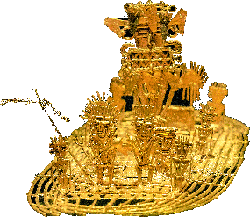
MUYSCA
The Muysca of Peru and Colombia are perhaps best known for their part in the origins of the legend of El Dorado.
The world and all that is in it was the creation of the sun, who is sometimes said to have the form of an ancient bearded man by the name of Bochia. Bochia, it is said, came down to the earth to teach the people the arts of agriculture and religious observation. This led Bochia's wife to become jealous of the time he spent with his creatures, resulting in her sending a flood in order to disrupt and devastate life on earth. The Sun, however, rectified this, and made the moon from his wife.
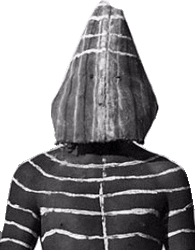
SELK'NAM
The Selk'nam recognise only one god, known as Temáukel. The supreme being is known among the Kawésqar as Xolas. Temáukel is said to dwell within the eastern sky of Wintek, and is credited with the creation of the heavens and primordial earth. The sky is divided into four sho'on, representing the four cardinal directions: -
- Wintek, the east, which signifies all the seasons and time itself;
- Kamuk, the north, spring and summer;
- Kenénik, the west, autumn; and
- Kéikruk, the south, winter.
In addition to Temáukel, the Selk'nam also revere a group of subsidiary beings, the Howenh, who initially existed as humans but later came to hold power over the elements as immortals. Among them was Kénos', the earliest inhabitant of the earth, who served as Temáukel's demiurge in the further creation and ordering of the world. Kénos' was succeeded by Čénuke, another powerful Howenh. Čénuke's contemporary and rival was Kwányip, the slayer of the cannibal giant Čáskels. Humans were created by El-lal, the son of the giant Nosjthej.
SHUAR (JIVARO)
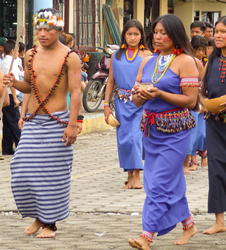
In the beginning, the creator Kumpara lived with Chingaso, his wife. Together, they had a son, Etsa, who was the sun.
One night, Kumpara spat forth some mud onto Etsa, producing Nantu, the moon. Etsa then prepared to marry Nantu - the manner in which she had been conceived meant that there was nothing incestuous about their relationship. Nantu, however, had other ideas, and escaped from his advances by going into the sky and painting herself in dark hues. Another who wished for her hand was the bird Auhu, but his attempt to follow her was curtailed when she cut the vine on which he was trying to reach the sky. By now incensed, Etsa decided to go to the sky himself to retrieve his bride, by means of parrots and parakeets. He caught up with Nantu and the pair fought, resulting in eclipses. Eventually, having been brought to heel, Nantu wept, which caused her face to grow red.
Nantu later left and produced a child, Nuhi, by breathing on some clay. Auhu now reappeared on the scene and smashed Nuhi, who became the earth.
Finally, Nantu agreed to marry Etsa and they had a son, Unushi, the first of the Jivaro. Unushi was a sloth, and was given the forest in which to live. Unushi was followed by various other animals who were the offspring of Etsa and Nantu's copulating on the earth. At some point, Chingaso sent an egg to the earth, which hatched, producing a woman, Mika, who was given to Unushi as a wife. Unushi's parents instructed the newlyweds as to their mode of life. Unushi, however, was an idler and did little by way of work. Hence, the women of the Shuar are far more hard-working than their male counterparts.
One day, Unushi and Mika sailed down the river in a canoe. They produced a son, the water snake Ahimbi. Additionally, Chingaso sent other eggs, which produced animals, including birds which helped Unushi and Mika find food. The anaconda fashioned an axe for them. Ahimbi chopped down a tree to make his own canoe as he wished to be independent. He eventually returned from his travels to find Mika alone, as Unushi had got himself lost. Ahimbi and Mika spent the night together, but were seen by Etsa, who exiled them for incest. They wandered in search of shelter, producing offspring as they went. They found no aid from the animals, as they too wished to have nothing to do with them. Finally, when Unushi got wind of his wife and son's predicament, he turned upon Nantu, who he blamed, and attaked her, burying her in a hole. She escaped thanks to some assistance from Auhu. However, her ingratitude led him to cry at night for her return.
After Nantu informed them of what had happened, the sons of Mika gathered together with Ahimbi at their head and slew Unushi. Mika, however, retaliated by killing the parricides, with their struggle resulting in lashing rain, lightning and thunder. From a thunderbolt sprang Masata ("War"), fully armed, who stirred up strife among men and gods.
Finally, Etsa and Nantu decided that Ahimbi was the guilty party in all of this, and Etsa imprisoned him beneath the great waterfall. Now wishing to make peace, he sends up water to make rainbows, so that Etsa will see that he means well. Unfortunately, Masata intervenes to maintain the status quo, by making mist and rain to block Ahimbi's signals. Indeed, the unfortunate Ahimbi was even responsible for the demise of Chingaso, after the great goddess sought to rescue him. Not recognising her, Ahimbi turned over her canoe and ate her.
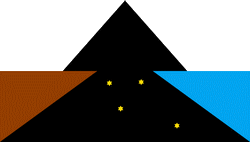
TEHUELCHE
The Tehuelche of Patagonia believe that Kóoch ordered the primitive cosmos. Kóoch was sent by the supreme being, who does not interfere with the universe he created, to bring order to the primordial world.
WARAO
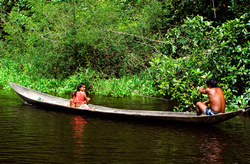
The Warao are descended from the primordial hunter, a heavenly man who dwelt within the sky world. This realm was the home of a tribe of humanoids as well as birds, but there were no land animals or fish. One day, whilst out hunting birds, the huntsman struck a bird in flight, whereupon the stricken creature fell down, striking the floor of the sky with such force that its fellow fowl managed to break through, flying away through the clouds to the earth below.
Following the game, the hunter also went through the hole, seeing the fertile earth through the hole and vowing to make his way down there to enjoy the goodness on offer. In order to carry out his plan, the hunter made a rope from cotton from the heavens and tied it to a tree, lowering himself down to the surface and forever eschewing is homeland.
WAYÚU (GUAJIRO)
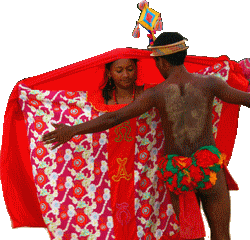
In the beginning, Maleiwa created the cosmos. He fashioned the first Wayuu people and instructed them in their way of life. Other important figures are the female-male pair Pulowi and Juyá, who are spiritual beings associated with procreation. Pulowi is a female, associated with wind and the dry season. Juyá is a nomad associated with hunting and the rains. Opposing them is Wanülu, an evil entity associated with illness and death.
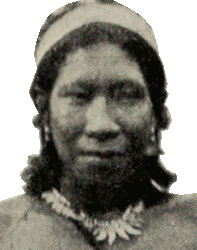
WITOTO
In the beginning, there was nothing but an illusion, Nainema. Nainema saw this illusion and brought it into himself, before beginning to think. Nainema sought the vision but, finding nothing, decided to try again. He eventually managed to tie the emptiness to a thread within the dream by means of glue. Then, he tamped down the bottom of the illusion until he could sit upon it, forming the earth he had dreampt about. From this seat, he spat forth, which created the forest. Then he lay down and made the sky above.
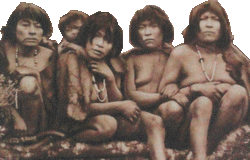
YAGHAN
The Yaghan have a creation myth centred upon the Yoalox-brothers, two culture heroes and lawgivers.
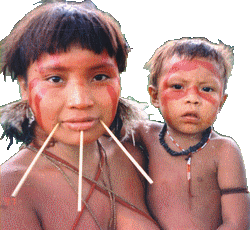
YANOMAMI
The world was created by Omam, who proceeded to make humans by having intercourse with a fish woman he caught in the river. Eventually, the people began to be oppressed by the Moon, who ate the souls of the offspring of the people. Suhirina, however, emerged to deal with this situation, shooting the moon with an arrow. A new people were formed from the blood which dripped from the moon. These are the Yanomami, whose strength is determined by their proximity to the centre of the blood pool.
YARURO (PUMÉ)
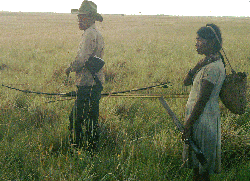
In the beginning, the world was an empty place. Within this, the water snake Puana appeared and formed the world. Water was created by Itciai, his jaguar brother, while their sister Kuma - wife of the Sun - made the Yaruro, allocating them to the clans set up in honour of the brothers. Later, the other peoples of the world were made, including the Racionales. The Yaruro had horses but were frightened, so gave them to these white-skinned people. The Sun visits his wife at night. Their children are the stars. The Moon is the sister of the Sun.
